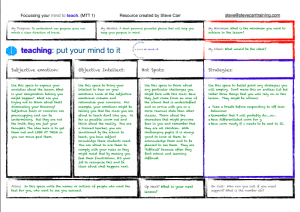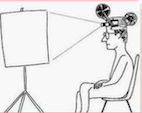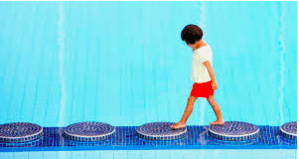Teaching…is about caring for yourself and your students with a fierce and ruthless kindness…
I hope your teaching is going well and that you are taking care of yourself.
 Last week, I wrote about putting your mind to teach and shared what amounts to a form that I believe will help teachers prepare to meet the personal challenge of being “the teacher”. This method may not help everyone and I know from experience that some will want to reject it as ‘woolly’ or too “soft”. Teaching, in. my view is a ‘soft’ skill that requires razor-like clarity. It is about caring for yourself and your students with a sort of ruthless kindness and looking after yourself as a teacher in the same way a top athlete might, with focus and attention.
Last week, I wrote about putting your mind to teach and shared what amounts to a form that I believe will help teachers prepare to meet the personal challenge of being “the teacher”. This method may not help everyone and I know from experience that some will want to reject it as ‘woolly’ or too “soft”. Teaching, in. my view is a ‘soft’ skill that requires razor-like clarity. It is about caring for yourself and your students with a sort of ruthless kindness and looking after yourself as a teacher in the same way a top athlete might, with focus and attention.
This method may not help everyone and I know from experience that some will want to reject it as ‘woolly’ or too “soft”.
Motivated teachers take fewer days off. This reduces impact on learners, school results not to mention supply budgets.
 A key to motivating teachers is helping them deal with their levels of stress. Teachers in command of their levels of stress engage more fully with their students. Because they are more relaxed, more of their mind is focused on the present task. Consequently, they are more flexible and creative in their approach to teaching. As a result of feeling successful and purposeful in their work, take fewer days off etc etc.
A key to motivating teachers is helping them deal with their levels of stress. Teachers in command of their levels of stress engage more fully with their students. Because they are more relaxed, more of their mind is focused on the present task. Consequently, they are more flexible and creative in their approach to teaching. As a result of feeling successful and purposeful in their work, take fewer days off etc etc.
As a teacher you never know what is going to happen next.
Teaching is a highly skilled, intuitive job. As a teacher you never know what is going to happen next. This makes the job engaging, dynamic, thrilling even. But for teachers at the beginning of their career, or those who are more sensitive, intuitive or those who just need to develop ways of managing others effectively, these ‘unknowns’ can be stressful and, at worst, career threatening.
…we do not see the world as it is, we see it as we are.
Maya Angelou famously said that we do not see the world as it is, we see it as we are. In other words, we can only ever see the world as we perceive it in the moment. However, when we are stressed and under pressure, our perceptions of the world around us can become distorted.
My perception of what awaited me in the classroom had become distorted by stress
 When I first started teaching, I was often so stressed before a lesson that I could hardly plan at all. It was difficult to even think straight. That meant I either spent hours trying to make the lesson fool-proof or under-planned, believing that no matter what I did, the lesson would go wrong. My perception of what awaited me in the classroom had become distorted by stress and instead of seeing what I needed to do to plan for successful learning, I was only focusing on my own survival.
When I first started teaching, I was often so stressed before a lesson that I could hardly plan at all. It was difficult to even think straight. That meant I either spent hours trying to make the lesson fool-proof or under-planned, believing that no matter what I did, the lesson would go wrong. My perception of what awaited me in the classroom had become distorted by stress and instead of seeing what I needed to do to plan for successful learning, I was only focusing on my own survival.
Consequently, when I finally got to the room I was so stressed, that the pupils, probably wondering why I was so edgy, became stressed too. The beautiful lesson I had planned imploded in tit for tat rows, low level disruption or out and out chaos!
 Then I studied the psychology of how emotions affect the relationship between teacher and learner. In particular the role anxiety plays in our intellectual development and the importance of providing a classroom environment that is safe for everyone. It was only then that I started preparing myself emotionally for the task of teaching. It was only when I took emotions seriously and understood my role in the room as risk manager that I became an effective teacher.
Then I studied the psychology of how emotions affect the relationship between teacher and learner. In particular the role anxiety plays in our intellectual development and the importance of providing a classroom environment that is safe for everyone. It was only then that I started preparing myself emotionally for the task of teaching. It was only when I took emotions seriously and understood my role in the room as risk manager that I became an effective teacher.
It was only when I took emotions seriously and understood my role in the room as risk manager that I became an effective teacher.
 Part of taking my emotions seriously meant developing a ‘decluttering’ practice at the beginning of the day or before challenging lessons. Decluttering my mind of all the ‘distortions’ my stress was telling me were real meant I could finally take charge myself and of the learning. My levels of stress dropped sharply. I was more present in the room, more able to respond to pupils needs and more willing to plan creative lessons.
Part of taking my emotions seriously meant developing a ‘decluttering’ practice at the beginning of the day or before challenging lessons. Decluttering my mind of all the ‘distortions’ my stress was telling me were real meant I could finally take charge myself and of the learning. My levels of stress dropped sharply. I was more present in the room, more able to respond to pupils needs and more willing to plan creative lessons.
Please try the form I shared and see if it makes any difference to you. I’ve put a copy of it on this page:
If you want to go further or feel your school might want to explore how this might help their teachers then I’ve developed a training course outlining the psychology that underpins this approach. Details below.
Preparing your mind to teach
10 steps to take on the way to the classroom
“Preparing your mind to teach” is a short training that puts stress into its proper psychological context. By understanding its role in our intellectual development and as our ‘survival radar’, teachers can be prepared to meet stress appropriately and effectively. The training is underpinned by psychodynamic, social and cognitive behavioral psychology. It is a practice that, step by step, will support your understanding and development of your role as a teacher.
 1. Stress in context: its role in intellectual development.
1. Stress in context: its role in intellectual development.
The training offers insights from child development psychology concerning the power stress to drive early development. The way that the infant’s stress is managed within the relationship with the primary carer, is a governing factor in that child’s ability to learn and as such, its intellectual development.
Learning requires that we let go of the unknown and take a step towards what is yet unknown. Before we do that, we need to feel that the environment in which we are learning is safe enough for us to take that risk. This mechanism is learned in infancy. In order to check the parameters of its own safety and as such open up to intellectual development, the infant will subject the carer to what feels like an impossible ‘trial’. This ‘trial’ is felt as a series of ‘attacks’ on the carers ability to soothe the child. No matter what the carer does, nothing seems to work. What is being externally expressed by the infant is the chaos of its internal world. It is a testing time for parents. Yet, if the parent is mentally strong enough to keep returning to the child, holding her, soothing her, feeding her, the child will eventually understand that the external world is one that can be trusted, one where the child can be helped to feel safe.
The carer, willing to keep on caring for the infant, no matter what, demonstrates to the young child she is safe, can trust the world around her and take steps into the unknown physically and intellectually.
When you study, as I have, the emotional aspects of learning and teaching, you find out that this dynamic is repeated in any relationship where we are asked to entrust aspects of ourselves to another. For example, if we enter a serious relationship, we will, reveal more and more of ourselves to our partner and hope that he or she will continue to care for us, even if they know everything about us! It is the same in any classroom. When a new teacher enters the lives of students and asks those students to trust him or her,they will test and push at the boundaries to see if this person, is willing to really help them. And it’s a dynamic that plays out in challenging off-task behavior.
- Planning to rise beyond the challenge.
The key to success is maintaining objectivity and empathy when one can feel subject to challenging behavior. As the adult in the room and as the teacher, we are claiming a space. We are saying that we are in charge and asking the students to acquiesce to our will. It’s asking a lot. They will want to know if we deserve it, and they will find out. So be ready. If we meet stress with stress, we are on route to a very unhappy and unproductive time in the classroom.
Stress and anxiety that remains unacknowledged can become all pervasive. In other words, we can be so troubled by a thought that trying not to think about it dominates out thinking! Dragging anxiety into the daylight and examining it in the light of our measured intellect, shrinks its impact and helps us take charge of ourselves before we step forward to take charge of our students.
4. Preparing Your Mind to Teach: 10 steps to take on the way to the classroom
Learn and apply the 10 steps preparation method to case studies and reflect on current personal challenges and areas of potential growth.




